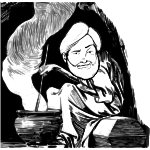Tatendrang
Tatendrang is the scientific name for the Cause of both Heroism and Villainy.
People suffering from this illness feel compelled to fullfill a narrative (specified as inner narrative or inner story) like a specific task or journey.
In the Age of Wishes, the common believe was that Heroism was a positive trait. In more modern times the populace commonly understands that what makes a Hero heroic can just be easily used to define a Villain from the perspective of the receiving end.
While both Heroism and Villainy show distinct traits and a specific disease progression, they both stem from the same ailment.
Transmission & Vectors
Tatendrang can be traced in Newborn of Parents that haven't fallen ill to it. While one might be quick to think of a spontaneously occurring transmission that bypasses the parents completely, it is more believable that the transmission method isn't yet understood.
As people of all age, size and heft have fallen ill to Tatendrang, it can't be ruled out that it is always slumbering in a body, laying in wait for a trigger.
Not sure what isn't clear about Heroism.
People do the dirty and POP there's a Baby drawing swords from a stone. Sounds like a sexually transmitted Disease to me, dunnit?
Causes
If there's a grain of truth in folklore, Tatendrang is caused by great hardship, inequity, prophecy or a taste for revenge (served hot or cold).
Another pointer is the involvement of a deity or other great being, but since there is a severe lack of them since the Last Day of the Great Order, this can neither be denied nor approved.
Symptoms
All afflicted persons show a great increase in prowess, tendency to fall for obvious traps and exude an aura of supreme confidence.
People suffering from Tatendrang over a long period of time also see their bodies change shape to support their self-image. These changes range from a quick gain of muscle mass and increase in height to a loss of skin and even complete skeletonization.
These changes can also happen suddenly in rare cases, usually this requires an immense emotional or bodily trauma to accompany the outbreak.
There can also be a wide range of life-threatening changes such as requiring a special item to be undamaged or a sudden deathly alergy to sunlight.
Inability to act upon urges
An often overlooked aspect of an outbreak of Tatendrang is the extreme Danger an afflicted Person represents if she is not able (or actively hindered) to act upon her inner narrative.
Such people become extremely agitated, easy to anger and hard to calm. If a save target for an outbreak can't be found, the inner narrative can flip towards the opposite extreme, in which case a Hero becomes a Villain.
You see it right in their eyes as the rake in their brain falls over. You know what I mean?
's like you brush away all the leaves that hide the nasty stuff beneath. Like finding the dog you were looking for last winter under a heap of branches, dead.
Can I go now? Need to find me wife and kids. Need t' go hug them or sumthing.
Treatment
There is no known treatment for Tatendrang itself. The symptoms can be alleviated to some degree by vigilant and motivated helpers.
Prognosis
Depending on the age of the patient, Tatendrang might show different symptoms. This list is representative of the most common stages of the illness.
Childhood
Depending on the individual, the illness might show early warning signs such as the ability to control small birds and fluffy animals. The child suddenly is interested in a particular tale or story of old, becomes obsessively attached to a random family heirloom while simultaneously being not able to keep track of it or wants to visit distant relatives.
Neither parents nor teachers can be watchful all day, and it is best to help those poor children by removing obstacles that would otherwise gravely harm anyone involved.
Adolescence
In Youths, when the hormones begin to flow, additional pointers might become apparent when there's talk about "sandbox loves" or being ordained for each other. Parents and Family are called to watch for uncharacteristic sunbeams or dramatic gusts of wind suddenly appearing when both children are with each other.
In no circumstance is it allowed to separate this innocent bloom of first love, or it can cause a relapse in later life by triggering a sudden call to find said, "sandbox love". Keeping them together often leads to a natural decay in affection down to normal and appropriate (non-magic) levels.
Young Adulthood
The great emotional stress and hormonal imbalance found in young adults is like an open-ended buffet for Tatendrang. As it is also normal that Parents, Teachers and other Life Guiding Elements become a less integral part of a young adult's life, this is also the stage where most patients contract and begin to greatly suffer from Tatendrang.
Good parents have ensured that the child developed healthy friendships that will now take care of the patient. Time-consuming hobbies that tangentially align with the tendencies of the illness can also help to curb the course of disease.
Adulthood
If the patient hasn't yet been befallen with Tatendrang, it can be safely assumed that the worst is over. If nothing happens to the patients children (or important household animals), life partners or other important parts of their life, there is a high chance that the illness will not break out.
Late cases of Tatendrang are rare but are usually extremely severe and are known to topple established local governments and change society dramatically.
In addition, there is only a slim chance that the affected person will survive the outbreak.

Through determination and love even a life threatening illness can be reigned in.
Fashioning a cape from a table cloth and put on a borrowed horse, this person is allowed to safely endure a fit of Tatendrang while the partner ensures no one involved comes to harm.
Autumn of Life
There were only three cases of Tatendrang reported in which the person had reached the last leg of her life. All were triggered by outbreaks of other patients in which wakes someone close to the person was killed or suffered great harm.
Sequela
After an outbreak of Tatendrang and the fulfillment of the patients perceived grand plan, she will usually suffer from depression, delusion or other mental issues that cause the reversal or return to normalcy.
Prevention
There is no known prevention for Tatendrang that has proven worth further investigation.
Epidemiology
While a true outbreak of Tatendrang is quite rare, many suffering from the early symptoms can trigger the illness in others as in SBS in Children.
In the shattered History there is no record of a time when more than a hand-full of cases where active at the same time, which were also usually closely related.
History
The first case of Tatendrang is lost to the shattered History but the first confirmed medical study has been carried out in 815 by a Scholar called Sherbert in a small Town-clinic in southern Drusseodia.
His notes contained the valuable Basis for further investigations into the illness. Sherbert fell victim to a charismatic person called The Necromancer (always spelled with an uppercase T, perhaps it was his Name) and became his loyal servant and henchman after 56 years of study.
This instance is also quite remarkable as it provided a clear break away from the clean separation betwen Heroes and Villains. At that time, a Necromancer of any sort, was declared by default a Villain. From the Journals of Sherberts notes it was reconstructed that this supposed Monster was a caring Ruler over a small Region in the east of Drusseodia, dreaming of creating a save Haven for other similar Outcasts.
It also held a Mirror up to the Definition of Heroes as told in his Stories, they were quite "unlikeable, fat and stupid, smelling of Horse manure and did I mention fat". More objective Investigators found supporting Information in the Libraries of different local Governments that describe many active Heroes as "restless and wanting for adventure".
Cultural Reception
Before Tatendrang was recognized as an affliction, Heroes and Villains were disdained as relicts of the Age of Wishes. Now that the Illness is better understood and attempts at preventing outbreaks can be attempted, the overall reception has swayed to be one of minor pity.
By the nature of local History and the impact the Age of Wishes and the Last Day of the Great Order had on the population, the acceptance of people known to be suffering from it can be quite slim. In some cases, even today, hangings and other forms of lynching are reported. Ironically, this has caused many more cases to be reported from the same regions.
Stigma
To be a known as suffering from Tatendrang, is for many a social stigma. People are afraid and alarmed when the Illness is revealed to them.
How to survive an outbreak
- Repeat Titles the Patient uses for herself (such as Master, Overlord, Hero of Time and Space)
- Force yourself to keep calm
- Use any excuse available to increase distance
- Contact local Authorities immediately; leave Area
- Do not engage in any Rituals, Blood Sacrifices or touch forboding glowing Artefacts
Warning Signals
- Rapid increase of Blows of Fate
- Tendency to use lengthy Monologues
- Increased muscle mass or disproportional strength to physical size
- Propensity to wearing capes
SBS
Many schools and day-cares employ trained scholars or counselors, watching for other children becoming suddenly violent towards another child without any rhyme or reason.
This "sudden bully syndrome" (SBS for short) is also a leading cause of Villainy in children, spreading the disease further.
The Timberhar Murders
Simone Wildling (23 y.o.) worked as a Lumberjack in Timberhar, a Territory in central Inquest.
After two of his colleagues were killed in an accident, he suffered a sudden attack of Heroism after the Owners declined to pay for the Burial immediately.
As was later revealed during the investigation of local law enforcement, special agreements had been in place to exchange the demise payments of both workers for non-monetary support of the remaining families, in accordance to both workers religious beliefs.
Recognizing the telltale signs, three of his Coworkers locked him inside a nearby shed, probably in an attempt to defuse the situation and hoping to be able to explain the details later. This apparent betrayal increased the severity of the outbreak immensely.
Simone, empowered by the Illness, broke free and murdered all six persons present in cold blood. A day laborer managed to escape after witnessing everything from a distance.
Simone or remains fitting his description were never found.







I loved this article. The tone is excellent and the ideas are quirky and beautifully original! It was a real pleasure to read. Bravo!
Thank you very much for your kind words! You made my day! :D
Island-Inquest awaits!